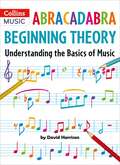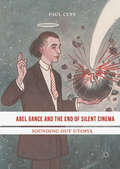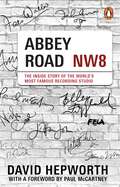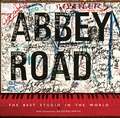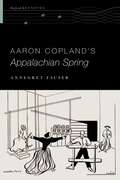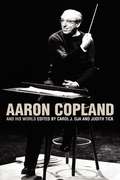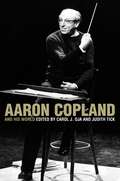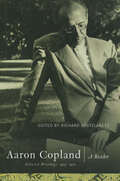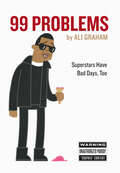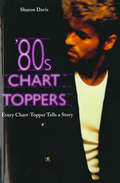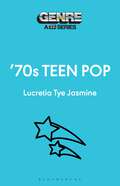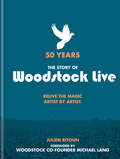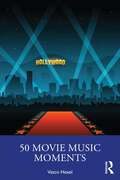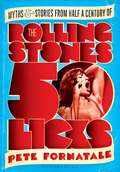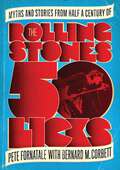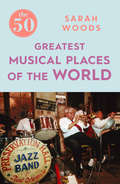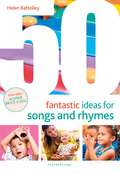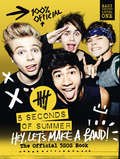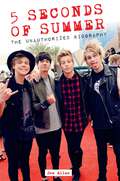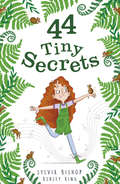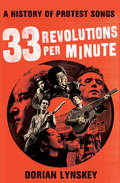- Table View
- List View
Abel Gance and the End of Silent Cinema: Sounding out Utopia
by Paul CuffThis book explores the creation and destruction of Abel Gance’s most ambitious film project, and seeks to explain why his meteoric career was so nearly extinguished at the end of silent cinema. By 1929, Gance was France’s most famous director. Acclaimed for his technical innovation and visual imagination, he was also admonished for the excessive length and expense of his productions. Gance’s first sound film, La Fin du Monde (1930), was a critical and financial disaster so great that it nearly destroyed his career. But what went wrong? Gance claimed it was commercial sabotage whilst critics blamed the director’s inexperience with new technology. Neither excuse is satisfactory. Based on extensive archival research, this book re-investigates the cultural background and aesthetic consequences of Gance’s transition from silent filmmaking to sound cinema. La Fin du Monde is revealed to be only one element of an extraordinary cultural project to transform cinema into a universal religion and propagate its power through the League of Nations. From unfinished films to unrealized social revolutions, the reader is given a fascinating tour of Gance’s lost cinematic utopia.
Abbey Road: The Inside Story of the World’s Most Famous Recording Studio (with a foreword by Paul McCartney)
by David HepworthWith a foreword by Paul McCartney'We wanted to live the mystique of this legendary studio' Kanye West 'There are certain things that are mythical. Abbey Road is mythical' Nile RodgersMany people will recognise the famous zebra crossing. Some visitors may have graffitied their name on its hallowed outer walls. Others might even have managed to penetrate the iron gates. But what draws in these thousands of fans here, year after year? What is it that really happens behind the doors of the most celebrated recording studio in the world?It may have begun life as an affluent suburban house, but it soon became a creative hub renowned around the world as a place where great music, ground-breaking sounds and unforgettable tunes were forged - nothing less than a witness to, and a key participant in, the history of popular music itself.What has been going on there for over ninety years has called for skills that are musical, creative, technical, mechanical, interpersonal, logistical, managerial, chemical and, romantics might be tempted add, close to magic.This is for the people who believe in the magic.
Abbey Road: The Best Studio in the World
by Alistair LawrenceThe first photographic celebration of the most famous recording studio in the world, publishing in its 80th year. Unprecedented access to the Abbey Road archive - from Edward Elgar to the Beatles, Kate Bush to Elbow the most famous artists in the world have recorded here.This gorgeous book includes material on the artists, the engineers, the technology and the history of Abbey Road. It's an incredible document of cultural history, for anyone who values music and how it's made.
AARON COPLAND'S APPALACHIAN SPRING OKS C (Oxford Keynotes)
by Annegret FauserAppalachian Spring, with music by Aaron Copland and choreography by Martha Graham, counts among the best known American contributions to the global concert hall and stage. In the years since its premiere-as a dance work at the Library of Congress in 1944-it has become one of Copland's most widely performed scores, and the Martha Graham Dance Company still treats it as a signature work. Over the decades, the dance and the music have taken on a range of meanings that have transformed a wartime production into a seemingly timeless expression of American identity, both musically and visually. In this Oxford Keynotes volume, distinguished musicologist Annegret Fauser follows the work from its inception in the midst of World War II to its intersections with contemporary American culture, whether in the form of choreographic reinterpretations or musical ones, as by John Williams, in 2009, for the inauguration of President Barack Obama. A concise and lively introduction to the history of the work, its realization on stage, and its transformations over time, this volume combines deep archival research and cultural interpretations to recount the creation of Appalachian Spring as a collaboration between three creative giants of twentieth-century American art: Graham, Copland, and Isamu Noguchi. Building on past and current scholarship, Fauser critiques the myths that remain associated with the work and its history, including Copland's famous disclaimer that Appalachian Spring had nothing to do with the eponymous Southern mountain region. This simultaneous endeavor in both dance and music studies presents an incisive exploration this work, situating it in various contexts of collaborative and individual creation.
Aaron Copland's Appalachian Spring (Oxford Keynotes)
by Annegret FauserAppalachian Spring, with music by Aaron Copland and choreography by Martha Graham, counts among the best known American contributions to the global concert hall and stage. In the years since its premiere-as a dance work at the Library of Congress in 1944-it has become one of Copland's most widely performed scores, and the Martha Graham Dance Company still treats it as a signature work. Over the decades, the dance and the music have taken on a range of meanings that have transformed a wartime production into a seemingly timeless expression of American identity, both musically and visually. In this Oxford Keynotes volume, distinguished musicologist Annegret Fauser follows the work from its inception in the midst of World War II to its intersections with contemporary American culture, whether in the form of choreographic reinterpretations or musical ones, as by John Williams, in 2009, for the inauguration of President Barack Obama. A concise and lively introduction to the history of the work, its realization on stage, and its transformations over time, this volume combines deep archival research and cultural interpretations to recount the creation of Appalachian Spring as a collaboration between three creative giants of twentieth-century American art: Graham, Copland, and Isamu Noguchi. Building on past and current scholarship, Fauser critiques the myths that remain associated with the work and its history, including Copland's famous disclaimer that Appalachian Spring had nothing to do with the eponymous Southern mountain region. This simultaneous endeavor in both dance and music studies presents an incisive exploration this work, situating it in various contexts of collaborative and individual creation.
Aaron Copland and His World (PDF)
by Carol J. Oja Judith TickAaron Copland and His World reassesses the legacy of one of America's best-loved composers at a pivotal moment--as his life and work shift from the realm of personal memory to that of history. This collection of seventeen essays by distinguished scholars of American music explores the stages of cultural change on which Copland's long life (1900 to 1990) unfolded: from the modernist experiments of the 1920s, through the progressive populism of the Great Depression and the urgencies of World War II, to postwar political backlash and the rise of serialism in the 1950s and the cultural turbulence of the 1960s. Continually responding to an ever-changing political and cultural panorama, Copland kept a firm focus on both his private muse and the public he served. No self-absorbed recluse, he was very much a public figure who devoted his career to building support systems to help composers function productively in America. This book critiques Copland's work in these shifting contexts. The topics include Copland's role in shaping an American school of modern dance; his relationship with Leonard Bernstein; his homosexuality, especially as influenced by the writings of André Gide; and explorations of cultural nationalism. Copland's rich correspondence with the composer and critic Arthur Berger, who helped set the parameters of Copland's reception, is published here in its entirety, edited by Wayne Shirley. The contributors include Emily Abrams, Paul Anderson, Elliott Antokoletz, Leon Botstein, Martin Brody, Elizabeth Crist, Morris Dickstein, Lynn Garafola, Melissa de Graaf, Neil Lerner, Gail Levin, Beth Levy, Vivian Perlis, Howard Pollack, and Larry Starr.
Aaron Copland and His World (The Bard Music Festival)
by Judith Tick Carol J. OjaAaron Copland and His World reassesses the legacy of one of America's best-loved composers at a pivotal moment--as his life and work shift from the realm of personal memory to that of history. This collection of seventeen essays by distinguished scholars of American music explores the stages of cultural change on which Copland's long life (1900 to 1990) unfolded: from the modernist experiments of the 1920s, through the progressive populism of the Great Depression and the urgencies of World War II, to postwar political backlash and the rise of serialism in the 1950s and the cultural turbulence of the 1960s. Continually responding to an ever-changing political and cultural panorama, Copland kept a firm focus on both his private muse and the public he served. No self-absorbed recluse, he was very much a public figure who devoted his career to building support systems to help composers function productively in America. This book critiques Copland's work in these shifting contexts. The topics include Copland's role in shaping an American school of modern dance; his relationship with Leonard Bernstein; his homosexuality, especially as influenced by the writings of André Gide; and explorations of cultural nationalism. Copland's rich correspondence with the composer and critic Arthur Berger, who helped set the parameters of Copland's reception, is published here in its entirety, edited by Wayne Shirley. The contributors include Emily Abrams, Paul Anderson, Elliott Antokoletz, Leon Botstein, Martin Brody, Elizabeth Crist, Morris Dickstein, Lynn Garafola, Melissa de Graaf, Neil Lerner, Gail Levin, Beth Levy, Vivian Perlis, Howard Pollack, and Larry Starr.
Aaron Copland: A Reader: Selected Writings, 1923-1972
by Richard KostelanetzThis book presents a selection of the best writings, of the American composer and music legend Aaron Copland, on a wide variety of topics. It features excerpts from his correspondence and recommendations he wrote for other composers.
Aaron Copland: A Reader: Selected Writings, 1923-1972
by Richard Kostelanetz Steve SilversteinThis book presents a selection of the best writings, of the American composer and music legend Aaron Copland, on a wide variety of topics. It features excerpts from his correspondence and recommendations he wrote for other composers.
99 Problems: Superstars Have Bad Days, Too
by Ali GrahamPoor Superstar. All the money and fame in the world won&’t prevent him from having a bad hair day. Or stepping in gum. Or not being able to fit into skinny jeans, or watching helplessly as a scoop of ice cream falls from its cone. Or so an unnamed Superstar&’s life is ingeniously imagined in this very funny book. Inspired by but not based on Jay Z&’s monster hit &“99 Problems,&” illustrator Ali Graham riffs on what might be the real problems afflicting a world-famous music mogul who also happens to be married to the foremost diva of our time. Begun as a Tumblr, which went viral almost instantly, 99 Problems is a highly conceptual gift book showcasing 99 full-color illustrations of a cartoon character who looks just like a certain legendary rapper, and the often ordinary and sometimes fantastical things that happen to him. And that&’s where the book finds its hilarious, compulsive hook—in an age that worships celebrity and assumes, somewhat enviously, that fame and fortune can protect one from life&’s travails, what if that just weren&’t true? There&’s a surprising, underlying warmth here. Even when the author dips into flights of pop culture fantasy—Superstar on the bow of the Titanic; Superstar whipping up a bad batch alongside Walter White from Breaking Bad—the recognition of shared kinship is strong. It&’s a cartoon version of celebrity, but like the best cartoons, it&’s edgy and knowing, yet sweet, too.
80s Chart-Toppers: Every Chart-Topper Tells a Story
by Sharon DavisThe '80s were a decade of musical change. As the '70s disco stranglehold was broken, rock, gay, dance and pop music competed with funk and soul, romantic ballads and political protest, computerised music and controversy. The glamour of costume, greasepaint and cross-dressing was put to good use by New Romantic groups like Spandau Ballet, Duran Duran, Soft Cell, Culture Club and the Human League, while the world also looked to Britain for the most exciting pop acts such as the multi-million-selling Wham!, Frankie Goes To Hollywood, Eurythmics and the Pet Shop Boys. Mainstream dance music was at its peak, spearheaded by Stock, Aitken and Waterman, and their stable of artists, including Kylie Minogue, Jason Donovan and Rick Astley, were all chart-topping names. From the USA came the artist of the decade, Michael Jackson, while Madonna and Whitney Houston provided the 'Girl Power' of the '80s. The decade also saw the philanthropic side of the music industry as the stars responded to famine in Ethiopia with the charity records 'Do They Know It's Christmas?' and 'We Are The World'. The'80s catered for all musical tastes, no matter how bizarre, and was far more eclectic than any other decade. From bubble-gum pop with Bucks Fizz to the stadium rock of Simple Minds,'80s Chart-Toppers brings a comprehensive year-by-year, month-by-month guide to the hottest sounds of the decade.
'70s Teen Pop (Genre: A 33 1/3 Series)
by Lucretia Tye JasmineTeen pop is a sub-genre of popular music marketed to tweens and teens. Its melodic yearning and veneer of sincerity appeal to an emerging romantic eroticism and autonomy. But tweens and teens buy music that isn't primarily marketed to them, too. Teen pop encompasses several kinds of musical styles, not limiting itself to just one-teen pop wants to play. During the 1970s, teen pop sometimes worked subversively, challenging the status quo it seemed to represent. Male pop stars such as David Cassidy were shown suggestively in popular magazines and female pop stars such as Cher had their own TV shows. Teen magazines, pin-ups, comics, films, and TV programs provided luscious visual stereo, promoting fashion styles, lingo, and dance moves, signaling individual identity but also community. The music provided a way for young people to believe they had something all their own, an authenticity experimenting with sexuality and social conduct, all dressed up in glitter and satin, blue jeans and boom boxes, torn fishnets and safety pins and, magically, their dreams. Cartoon pop and made-for-TV bands! Bubblegum pop! Glam! Hip hop! Hard rock and pop rock and stadium rock! Punk! Disco! Teen pop reinforced aspects of the counterculture it absorbed as the music kept playing-and playing back.Although it's very difficult to attain and maintain social progress and play it forward-there are so many tragedies-'70s Teen Pop examines how liberation and a true counterculture can be possible through music.
'70s Teen Pop (Genre: A 33 1/3 Series)
by Lucretia Tye JasmineTeen pop is a sub-genre of popular music marketed to tweens and teens. Its melodic yearning and veneer of sincerity appeal to an emerging romantic eroticism and autonomy. But tweens and teens buy music that isn't primarily marketed to them, too. Teen pop encompasses several kinds of musical styles, not limiting itself to just one-teen pop wants to play. During the 1970s, teen pop sometimes worked subversively, challenging the status quo it seemed to represent. Male pop stars such as David Cassidy were shown suggestively in popular magazines and female pop stars such as Cher had their own TV shows. Teen magazines, pin-ups, comics, films, and TV programs provided luscious visual stereo, promoting fashion styles, lingo, and dance moves, signaling individual identity but also community. The music provided a way for young people to believe they had something all their own, an authenticity experimenting with sexuality and social conduct, all dressed up in glitter and satin, blue jeans and boom boxes, torn fishnets and safety pins and, magically, their dreams. Cartoon pop and made-for-TV bands! Bubblegum pop! Glam! Hip hop! Hard rock and pop rock and stadium rock! Punk! Disco! Teen pop reinforced aspects of the counterculture it absorbed as the music kept playing-and playing back.Although it's very difficult to attain and maintain social progress and play it forward-there are so many tragedies-'70s Teen Pop examines how liberation and a true counterculture can be possible through music.
50 Years: Relive the Magic, Artist by Artist
by Julien BitounForeword by Woodstock co-founder, Michael Lang.3 days. 33 concerts. 2 deaths. 2 births. 500,000 people. And another 250,000 stuck in traffic trying to get in. Woodstock was a festival like no other. Now, on its 50th anniversary, relive every moment.Detailed text and evocative photographs tell the full story of every single act that performed - when they took to the stage, what songs they played, who was there, what they were like. From The Who to Hendrix, Jefferson Airplane to Creedence Clearwater Revival, every single second is an experience to enjoy over and over again.Also includes fascinating features on the stories around Woodstock, from the unique social and political context to the drugs, the free love, the film, the albums and the legacy.
50 Movie Music Moments
by Vasco Hexel50 Movie Music Moments comprises a wide-ranging collection of analyses of some of the most fascinating uses of music in modern Hollywood cinema. Considering narrative strategies, filmmaking techniques, functions of film music, audience engagement and conditioning, cultural implications, and intertextuality, the case studies gathered here introduce music as a crucial element of film. In 50 examples drawn from popular and critically acclaimed Hollywood films from the late 1950s to the present, the collection showcases the many dimensions of film music and its role in cinematic storytelling. Each example includes an analysis addressing the film’s context and providing a close reading of how music, narrative, and visual elements of the scene interact. Case studies exploring the role of music in film include Amadeus, Gladiator, Baby Driver, The Dark Knight, Philadelphia, Schindler’s List, and Black Panther. This invaluable collection offers an ideal resource to support undergraduate and graduate courses in film music history, film scoring, and filmmaking, as well as readers with a general interest in music in film.
50 Movie Music Moments
by Vasco Hexel50 Movie Music Moments comprises a wide-ranging collection of analyses of some of the most fascinating uses of music in modern Hollywood cinema. Considering narrative strategies, filmmaking techniques, functions of film music, audience engagement and conditioning, cultural implications, and intertextuality, the case studies gathered here introduce music as a crucial element of film. In 50 examples drawn from popular and critically acclaimed Hollywood films from the late 1950s to the present, the collection showcases the many dimensions of film music and its role in cinematic storytelling. Each example includes an analysis addressing the film’s context and providing a close reading of how music, narrative, and visual elements of the scene interact. Case studies exploring the role of music in film include Amadeus, Gladiator, Baby Driver, The Dark Knight, Philadelphia, Schindler’s List, and Black Panther. This invaluable collection offers an ideal resource to support undergraduate and graduate courses in film music history, film scoring, and filmmaking, as well as readers with a general interest in music in film.
50 Licks: Myths and Stories from Half a Century of the Rolling Stones
by Peter FornataleOn July 12, 1962, London's Marquee Club debuted a new act, a blues-inflected rock band named after a Muddy Waters song - The Rolling Stones. They were a hard-edged band with a flair for the dramatic, styling themselves as the devil's answer to the sainted Beatles.A young, inexperienced producer named Andrew Loog Oldham first heard the band at a session he remembers with four words: 'I fell in love.' Though unfamiliar with such basic industry practices as mixing a recording, he made a brilliant decision - he pitched the band to a studio that had passed on the Beatles. Afraid to make the same mistake twice, they signed the Stones, and began a history-making career.This is just one of the 50 classic stories that make up 50 Licks. Many are never-before told, some are from exclusive interviews - including with elusive bassist Bill Wyman - and all are illustrated and told by the people who lived them.Half a century on, the Rolling Stones are still the greatest band working. And this is the book to commemorate their unparalleled achievement in rock music.
50 Licks: Myths and Stories from Half a Century of the Rolling Stones
by Peter FornataleBehold the Rolling Stones: run-ins with the law, chart-topping successes, and now the World's Greatest Continually Operating Rock and Roll Band. 50 Licks tells the story of the Stones, right from its very origins.On July 12, 1962, London's Marquee Club debuted a new act, a blues-inflected rock band named after a Muddy Waters song-the Rolling Stones. They were a hard-edged band with a flair for the dramatic, styling themselves as the devil's answer to the sainted Beatles.A young, inexperienced producer named Andrew Loog Oldham first heard the band at a session he remembers with four words: "I fell in love." Though unfamiliar with such basic industry practices as mixing a recording, he made a brilliant decision-he pitched the band to a studio that had passed on the Beatles. Afraid to make the same mistake twice, they signed the Stones, and began a history-making career.This is just one of the fifty classic stories that make up 50 Licks, each named for a different Stones song. Many are never before told, some are from exclusive interviews-including with elusive bassist Bill Wyman-and all are told by the people who lived them. Part oral history, part memorabilia, this fiftieth anniversary book is the Stones album every collector will need to have.
The 50 Greatest Musical Places (The\50 Ser.)
by Sarah WoodsA trip around the world, played out to the most eclectic soundtrack, discovering hidden musical gems along the way. From mosh pits to cabarets, Berlin’s beatnik band haunts to Korea’s peppy k-pop clubs, from visiting the infamous Dollywood, to tracing Freddie Mercury’s childhood in Zanzibar, The 50 Greatest Musical Places of the World has something for music fans of all genres. Discover the places where iconic songs were written, groups were formed, music legends were born and extraordinary talent is celebrated.
50 Fantastic Ideas for Songs and Rhymes (50 Fantastic Ideas)
by Helen BattelleyThere's no better way to get children moving, laughing and learning than with songs and dance, but sometimes it can feel like you've exhausted your rhyme repertoire or simply run out of musical steam. 50 Fantastic Ideas for Songs and Rhymes offers a mixture of traditional favourites, fresh alternatives to well-known rhymes, action songs, original rhythms and funny verse that will have everyone giggling. All activities include suggestions for actions and dances and tips for incorporating songs and rhymes into other areas of children's learning.Adults will feel confident singing and moving to music with children, whether one-to-one or in groups, and children will love the repetition, rhymes and rhythmic movements of these activities. Drawing on developmental research to compile the very best musical activities, this book will boost practitioners' confidence and improve children's cognitive abilities and movement skills.With over 40 books in the 50 Fantastic Ideas series there's something for everyone – whether you're a practitioner looking for new ideas or you want to try out a popular well-loved activity with a new twist. Each book offers a wide range of fun and creative activities to carry out with children aged 0 – 5 years, with lists of resources, step-by-step instructions and information about the benefits for children.
5 Seconds of Summer: Hey, Let's Make A Band! - The Official 5sos Book
by 5 Seconds of SummerThis book is pretty much our official story so far. It really does only seem like last week we played our first gig in at the Annandale hotel in Sydney. Since then we’ve been given the opportunity to turn into the people and musicians we wanted to be.
5 Seconds of Summer: The Unauthorized Biography
by Joe AllanThe biography of the hottest new Australian band taking the pop world by storm. Luke, Michael, Calum and Ashton have become an overnight sensation, topping the charts in fifty-one countries and selling out their first US solo tour in just five minutes.From their humble beginnings posting videos of their songs on YouTube to supporting One Direction on tour and releasing their first album, the past year has been a roller-coaster journey for the boys. 5 Seconds of Summer: The Unauthorized Biography explores the early lives and backgrounds of the boys, their determination to gain recognition, touring with One Direction and coping with sudden international fame.This is the story of four talented, fun and down-to-earth boys who refuse to be known as just another boy band, and is a must-have for any 5SOS fan.
44 Tiny Secrets (44 Tiny Secrets #1)
by Sylvia BishopThe first book in a heartwarming and timeless new series with a brave and spirited heroine, from the acclaimed duo behind THE BOOKSHOP GIRL. Betsy Bow-Linnet is determined to become a world famous concert pianist like her parents. There’s just one problem: no matter how hard she practises she doesn't share their musical talents. So when a mysterious letter arrives from a woman claiming to know of an unusual Method that will make Betsy’s playing ‘stupendous’, Betsy jumps at the chance. There's just one condition: she must keep the Method a secret. But it isn't just one secret – it's forty-four tiny secrets in the shape of a boxful of pygmy mice! Betsy is mystified – how are they going to help her play the piano and – more importantly – how on earth can she keep them all a secret? Gorgeously illustrated in two-colour, this is a warm, funny and pitch-perfect story about the true nature of family love and finding your real talents in the most unexpected of places. Perfect for fans of ISADORA MOON, AMELIA FANG, OTTOLINE and HARPER.
33 Revolutions Per Minute: A History Of Protest Songs
by Dorian LynskeyWhy 33? Partly because that's the number of rotations performed by a vinyl album in one minute, and partly because it takes a lot of songs to tell a story which spans seven decades and five continents - to capture the colour and variety of this shape-shifting genre. This is not a list book, rather each of the 33 songs offers a way into a subject, an artist, an era or an idea. The book feels vital, in both senses of the word: necessary and alive. It captures some of the energy that is generated when musicians take risks, and even when they fail, those endeavours leave the popular culture a little richer and more challenging. Contrary to the frequently voiced idea that pop and politics are awkward bedfellows, it argues that protest music is pop, in all its blazing, cussed glory.
